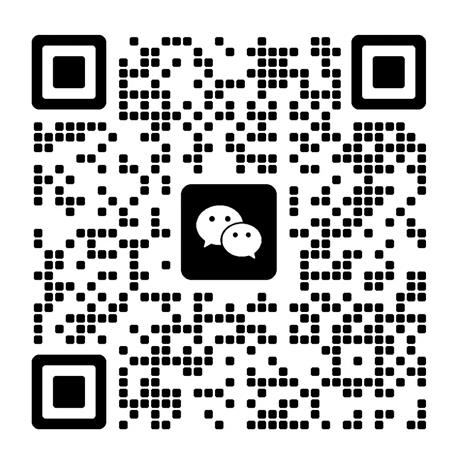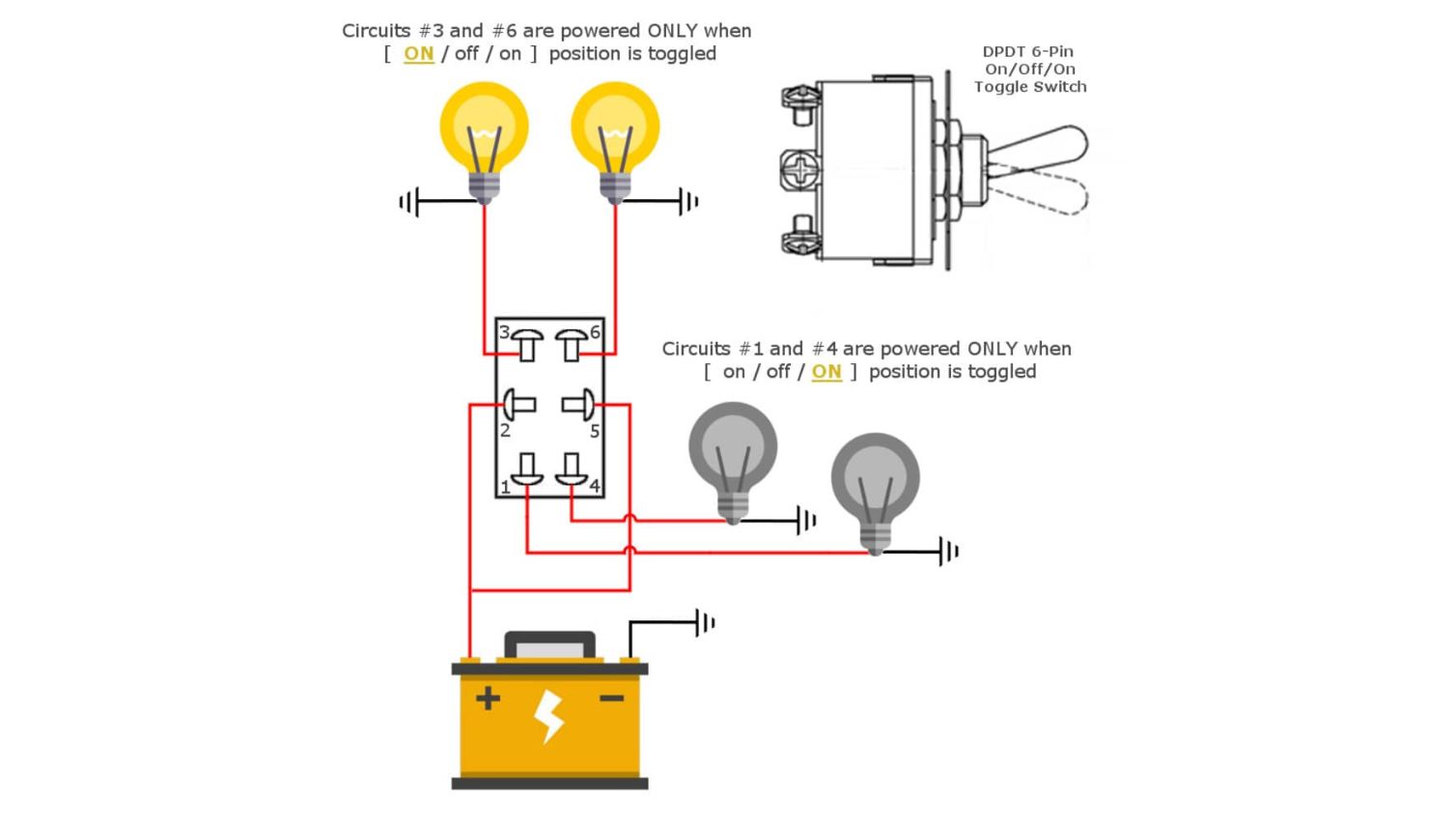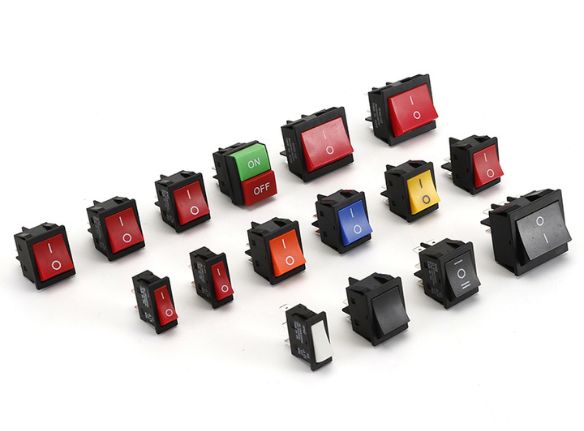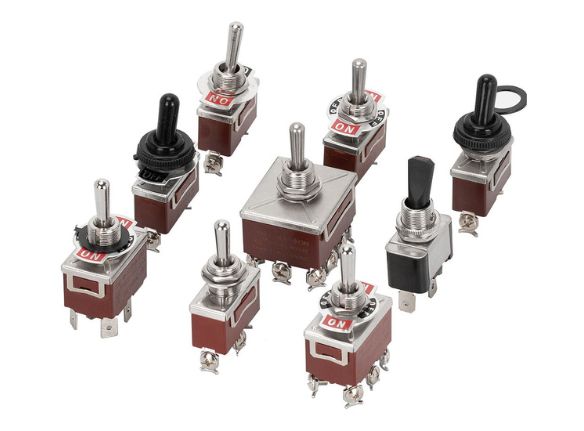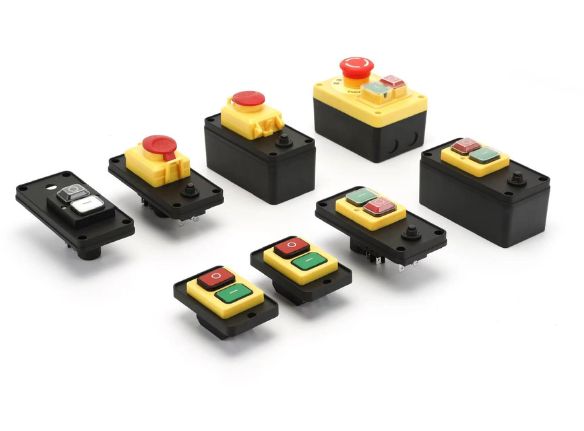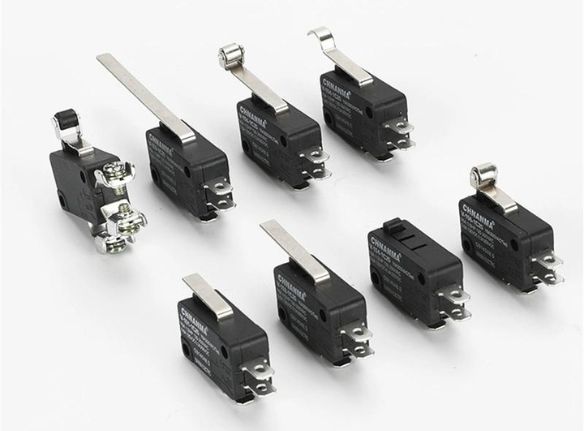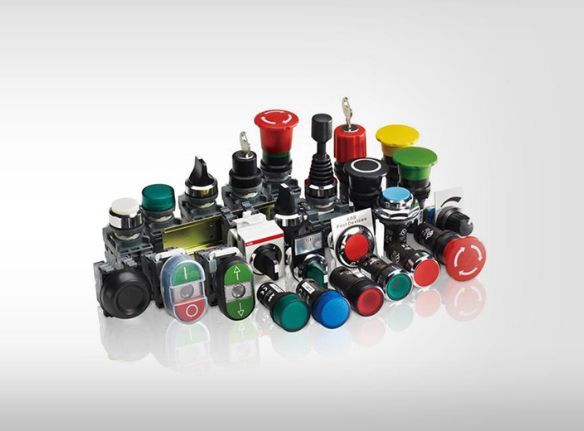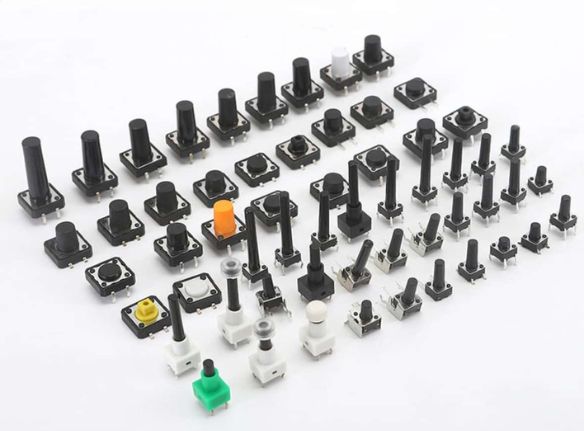In the intricate world of electrical components, switches play a fundamental role in controlling the flow of current, enabling the functionality of countless devices and systems. Among the diverse array of switch types available, the Double Pole Double Throw (DPDT) switch stands out for its remarkable versatility and capability to manage complex circuit configurations. This component, a cornerstone in many electrical and electronic designs, is more than just a simple on/off mechanism; it’s a sophisticated electromechanical switch that offers engineers, technicians, and procurement specialists enhanced control over multiple circuits simultaneously.
Understanding the nuances of a DPDT switch is crucial for anyone involved in designing, building, or maintaining electrical systems. Whether you’re working on industrial control panels, intricate test equipment, automotive applications, or even sophisticated hobbyist projects, the ability of a DPDT switch to route signals, reverse motor polarity, or switch between power sources makes it an invaluable asset. This guide is designed specifically for potential buyers and users – the engineers seeking reliable components, the technicians implementing designs, the procurement specialists sourcing parts, and the dedicated hobbyists pushing the boundaries of their creations. Our goal is to provide a thorough, practical understanding of what a DPDT switch is, how it works, its various forms, and its key applications, empowering you to confidently select and utilize the right switch for your specific needs.
Understanding the Basics: Poles and Throws Explained
Before diving deep into the specifics of the DPDT switch, it’s essential to grasp the fundamental concepts that define any switch’s operation: poles and throws. These terms describe the internal configuration and switching capabilities of the component, forming the basis for classifications like SPST, SPDT, DPST, and the focus of our discussion, DPDT.
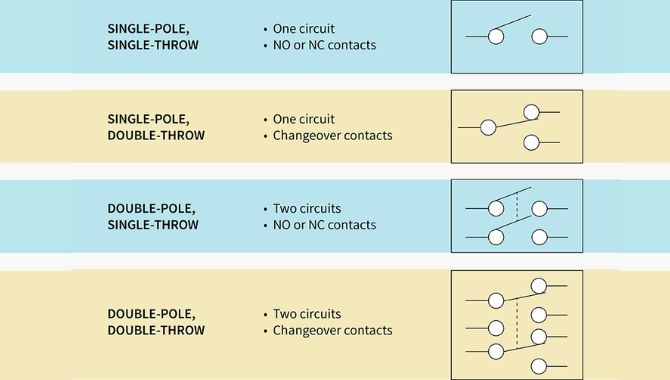
What is a Switch Pole?
The term ‘pole‘ refers to the number of separate electrical circuits that a single switch can control. Think of each pole as an independent switch operating under a single command (the actuator). A single-pole switch controls just one circuit. If you imagine a simple light switch turning a single light bulb on or off, that’s typically a single-pole operation – it controls one pathway for electricity. A double-pole switch, as the name suggests, controls two separate and electrically isolated circuits simultaneously. It’s like having two independent light switches mechanically linked together, operated by the same lever or button, controlling two different light bulbs (or perhaps a light and a fan) at the same time.
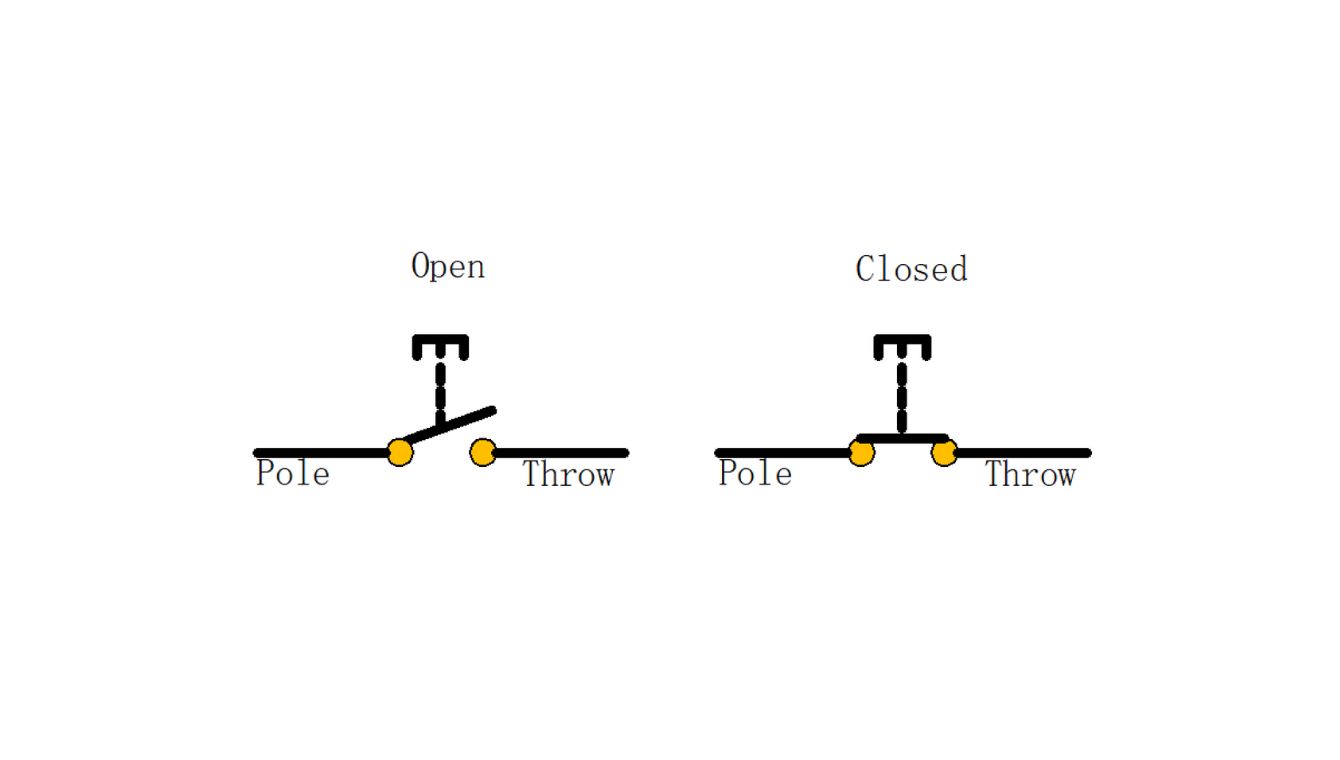
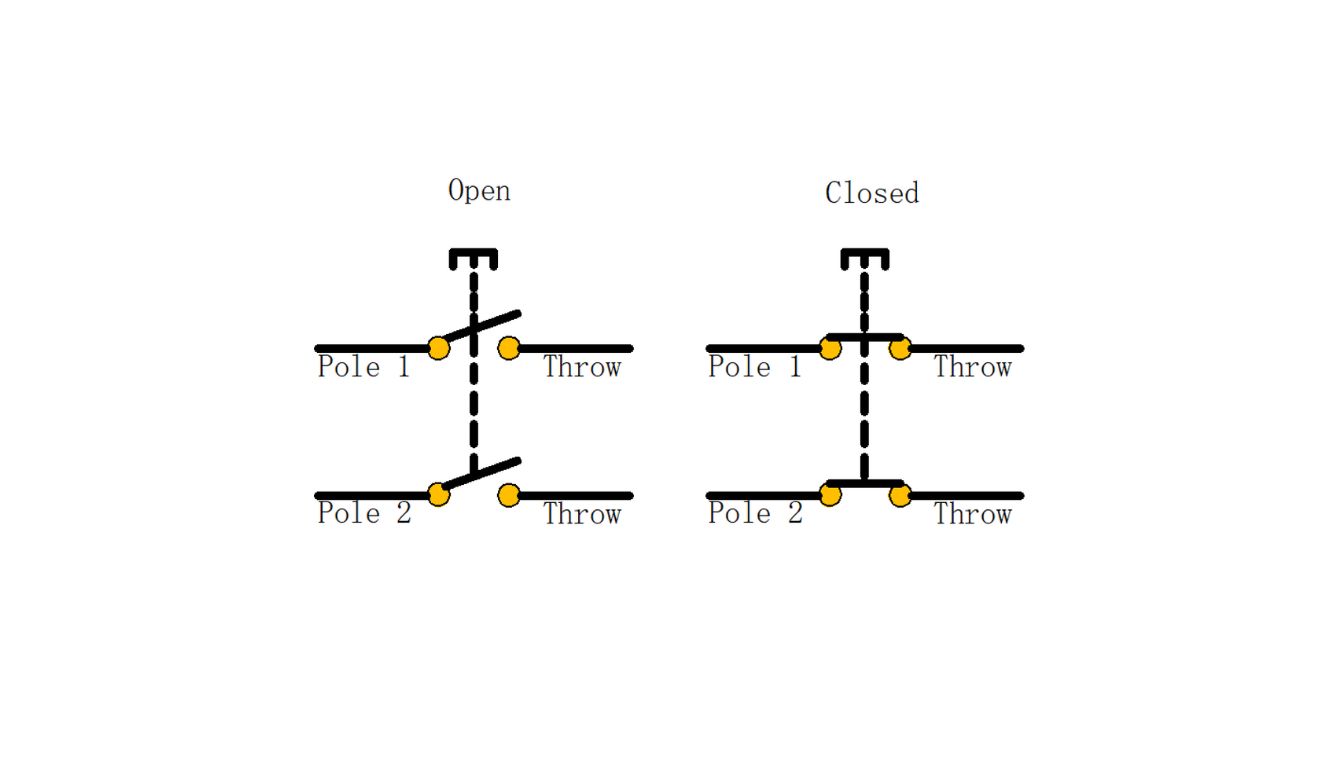
What is a Switch Throw?
The ‘throw‘ indicates the number of distinct output connections or positions that each pole of the switch can connect its input to. A single-throw switch has only one output connection per pole, essentially providing a simple ON/OFF function for the circuit(s) it controls. When the switch is ‘ON’, the pole connects the input to its single output; when ‘OFF’, the connection is broken. A double-throw switch, however, offers each pole two possible output connections. This means the input connected to the pole can be directed (or ‘thrown’) towards one of two different paths or circuits. Imagine a fork in the road; a double-throw switch allows the current to be directed down either path A or path B from a single starting point (the pole).
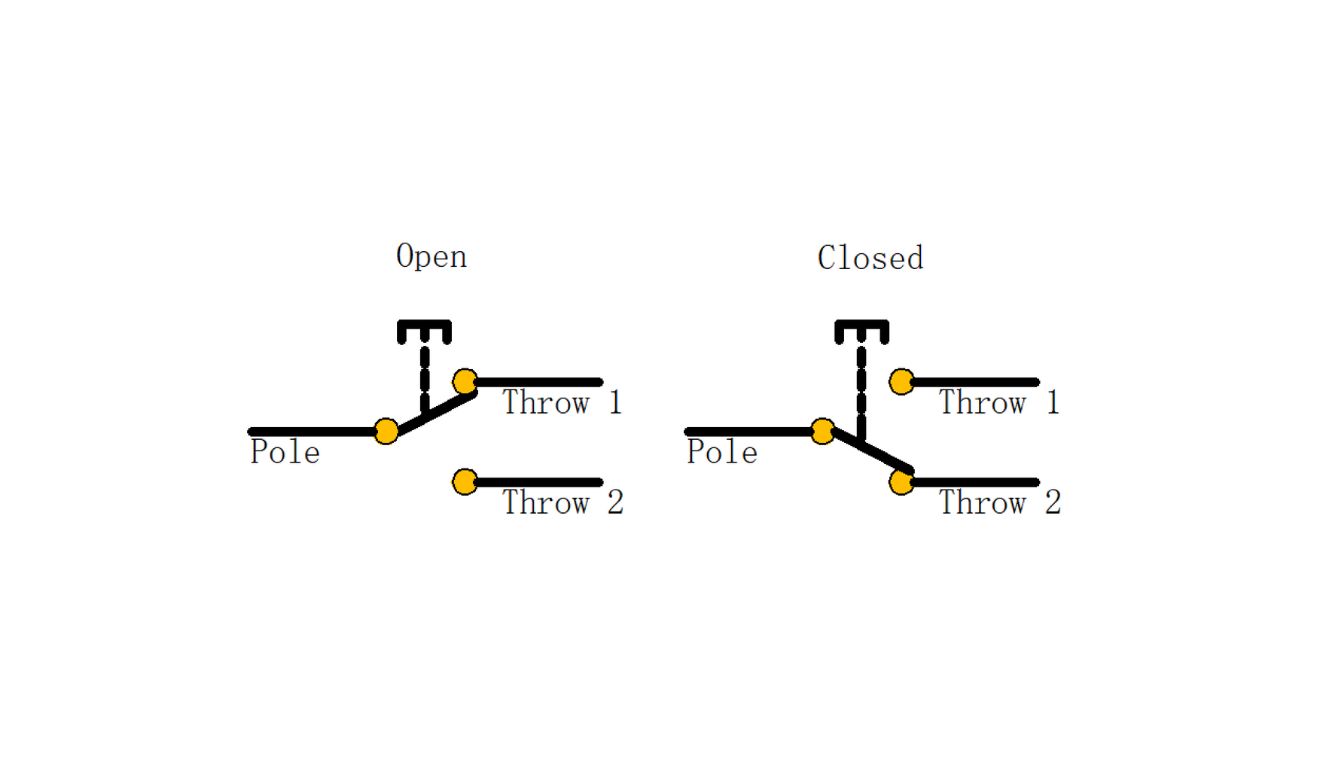
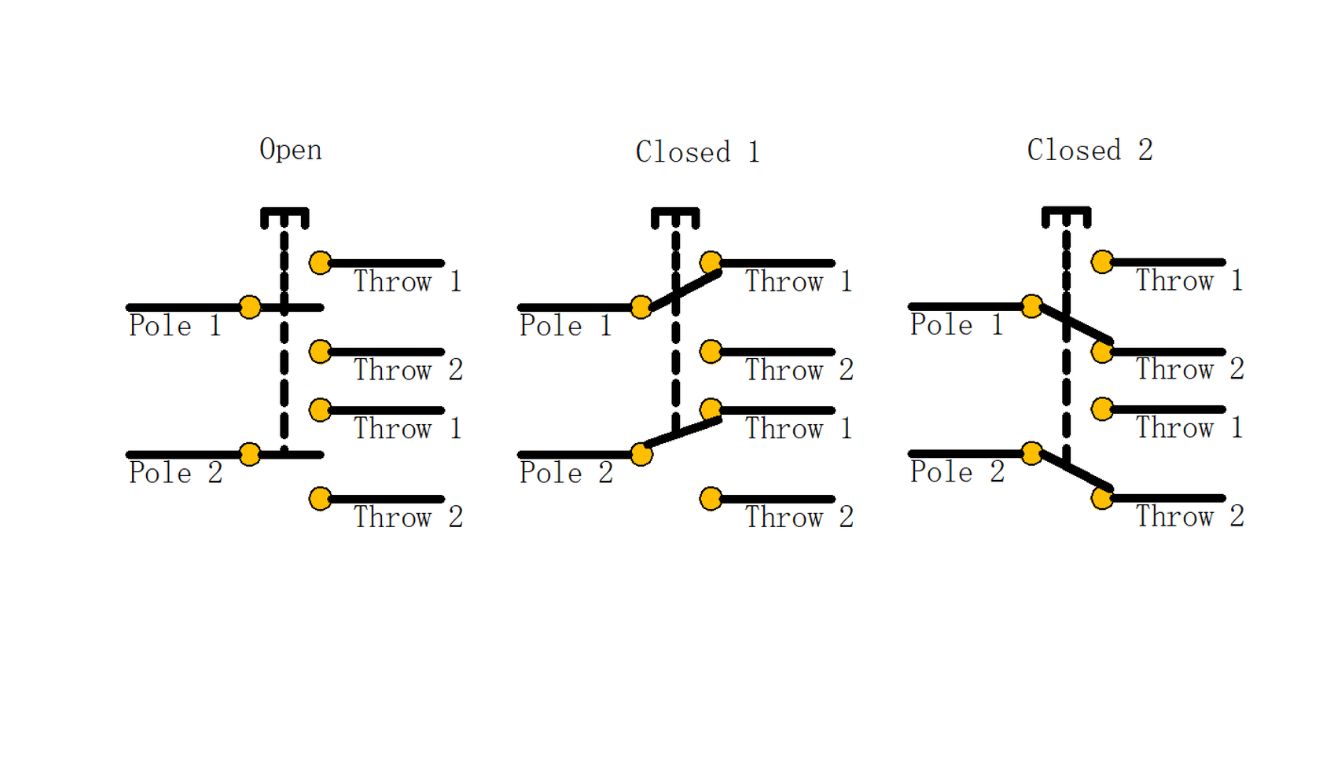
How Poles and Throws Combine: An Overview
The combination of poles and throws defines the switch’s functionality:
- SPST (Single Pole Single Throw): The simplest type. One pole, one throw. Controls a single circuit with an ON/OFF function.
- SPDT (Single Pole Double Throw): One pole, two throws. Controls a single input circuit, directing it to one of two possible output paths (A or B).
- DPST (Double Pole Single Throw): Two poles, one throw per pole. Simultaneously controls two independent circuits with a single ON/OFF action for both.
- DPDT (Double Pole Double Throw): Two poles, two throws per pole. Simultaneously controls two independent circuits, directing each to one of two possible output paths. This is the most versatile of the four basic types, essentially acting like two SPDT switches linked together.

Understanding these basic building blocks – the pole defining the number of controlled circuits and the throw defining the number of output options per pole – is key to appreciating the unique capabilities and applications of the Double Pole Double Throw (DPDT) switch.
Defining the Double Pole Double Throw (DPDT) Switch
Now that we have a grasp of poles and throws, let’s focus specifically on the Double Pole Double Throw (DPDT) switch. This component represents a significant step up in complexity and capability compared to simpler SPST or DPST switches, offering a level of control essential for many advanced applications.
Core Definition: What Makes a Switch DPDT?
At its heart, a DPDT switch is defined by its configuration: Double Pole and Double Throw. This means:
- Double Pole: The switch contains two identical, electrically isolated poles. Each pole acts as an independent switching mechanism capable of controlling its own circuit.
- Double Throw: Each of these two poles can connect its respective input terminal to one of two possible output terminals. This gives each pole two distinct ‘ON’ positions or paths it can direct current through.
The crucial aspect is that both poles are mechanically linked and operated simultaneously by a single actuator (like a toggle, rocker, or slide). When you flip the switch, both poles change their connection state in tandem, moving from one ‘throw’ position to the other. This simultaneous action on two independent circuits, each with two output options, is the defining characteristic and the source of the DPDT switch’s power and versatility.
Key Characteristics of a DPDT Switch
Beyond the core definition, several key characteristics define a typical DPDT switch:
- Six Terminals: The most common configuration features six terminals. Two of these are the input or ‘common’ terminals (one for each pole), and the remaining four are the output terminals (two possible outputs for each pole).
- Simultaneous Control: A single physical action on the actuator controls the state of two separate circuits.
- Internal Structure: Functionally, a DPDT switch behaves like two SPDT (Single Pole Double Throw) switches housed together and linked to the same actuator. Understanding the SPDT switch is often a stepping stone to understanding the DPDT.
- Versatile Configurations: DPDT switches are commonly available in maintained (ON-ON) or momentary configurations, as well as center-off (ON-OFF-ON) versions, adding another layer of control flexibility.
The DPDT Schematic Symbol Explained
Electrical schematics use standardized symbols to represent components, and the DPDT switch is no exception. Understanding its symbol is key to reading circuit diagrams.
(Placeholder: Clear image of the standard DPDT schematic symbol)
The symbol typically shows two separate input terminals (the commons, often depicted as the pivot point of the switch contacts). Each common terminal has two corresponding output terminals it can connect to. A dotted line often links the movable parts (the ‘wipers’ or contacts) of the two poles, indicating they are mechanically ganged together and move as one unit when the switch is actuated. This visual representation clearly illustrates the ‘two poles, two throws per pole’ structure and the linked operation.
How Does a DPDT Switch Work? The Mechanism Inside
Understanding the definition and characteristics is important, but knowing how a DPDT switch achieves its functionality provides deeper insight for application and selection. It involves a coordinated internal mechanism that reliably connects and disconnects multiple terminals.
The Internal Switching Mechanism
Inside the housing of a DPDT switch, you’ll find two sets of contacts corresponding to the two poles. Each set typically consists of a common terminal connected to a movable contact (the wiper) and two fixed output terminals. The actuator (toggle, rocker, etc.) is mechanically linked to both wipers. When the actuator is moved, it physically pushes both wipers simultaneously, causing them to break connection with one set of output terminals and make connection with the other set. The two sets of contacts (poles) are kept electrically isolated from each other within the switch housing. The quality of these contacts, often made from materials like silver alloy, copper, or gold plating, is crucial for reliable operation, low resistance, and long lifespan, especially in demanding industrial control or low-signal applications.
Switching Action: Connecting Inputs to Outputs
Let’s visualize the action in a standard ON-ON DPDT switch with terminals labeled 1-6 (where 2 and 5 might be the common inputs):
- Position 1: When the actuator is in the first position, the internal mechanism connects common terminal 2 to output terminal 1, AND simultaneously connects common terminal 5 to output terminal 4. Terminals 3 and 6 are disconnected.
- Position 2: When the actuator is moved to the second position, the connections change. Common terminal 2 now connects to output terminal 3, AND simultaneously common terminal 5 connects to output terminal 6. Terminals 1 and 4 are now disconnected.
This coordinated switching allows, for example, one circuit (connected via terminals 2, 1, 3) and a second, completely separate circuit (connected via terminals 5, 4, 6) to be switched between two different states or paths using a single control action.
Common DPDT Configurations: ON-ON vs. ON-OFF-ON
While the basic mechanism is the same, DPDT switches come in different functional configurations:
- ON-ON: This is the most basic DPDT configuration. The switch has two active positions. In each position, the common terminals are connected to one set of output terminals. There is no ‘off’ position; the poles are always connected to one throw or the other. This is ideal for selecting between two different operating modes or signal paths.
- ON-OFF-ON: This popular variant adds a third, central position to the actuator’s travel. In this center position, the common terminals are disconnected from all output terminals. This provides a distinct ‘off’ or neutral state, useful for applications requiring the ability to completely halt both controlled circuits, in addition to selecting between two active modes. Think of motor controls (Forward-Off-Reverse) or power switching (Source A-Off-Source B).
Understanding these configurations is vital when selecting a DPDT switch, as the choice directly impacts how the circuits can be controlled.
Why Choose a DPDT Switch? Key Advantages and Benefits
The complexity of the Double Pole Double Throw (DPDT) switch directly translates into significant advantages for circuit designers and engineers. Its unique structure unlocks capabilities that simpler switches cannot offer, making it the preferred choice for a wide range of demanding tasks.
Unmatched Versatility in Circuit Control
The core strength of the DPDT switch lies in its inherent versatility. By providing simultaneous control over two independent circuits, each with two output options, it can implement complex logic and switching functions using a single component. This simplifies designs, reduces component count, and can lead to more compact and cost-effective solutions compared to using multiple simpler switches or relays to achieve the same result. Its ability to handle intricate signal routing or mode selection tasks is unparalleled among basic switch types.
Simultaneous Control of Two Independent Circuits
This is a fundamental benefit. Imagine needing to switch both the positive and negative lines of a power supply, or controlling two different signal paths concurrently. A DPDT switch achieves this with one actuation. This simplifies the user interface and ensures that related circuits are always switched in a synchronized manner, which is critical in many control systems and safety applications. It eliminates the potential for errors that could arise if two separate switches needed to be operated in unison.
Enabling Polarity Reversal
One of the most common and powerful applications of a DPDT switch is polarity reversal, particularly for DC motor control. By cleverly cross-wiring the output terminals, a DPDT switch can effectively reverse the direction of current flow through a load connected to the common terminals. Flipping the switch one way makes the motor spin forward; flipping it the other way reverses the polarity applied to the motor, causing it to spin backward. This H-bridge-like functionality achieved with a single, robust component is incredibly useful in robotics, automation, and any application requiring bidirectional motor movement.
Enhanced Safety in Mains Switching
When dealing with mains electricity (AC power), safety is paramount. In many regions and applications, safety standards require switching both the live (hot) and neutral connections simultaneously. A DPDT switch (or its single-throw counterpart, the DPST) is ideal for this. By using one pole for the live line and the other pole for the neutral line, the switch ensures a complete disconnection of the appliance or circuit from the mains supply when turned off, providing an extra layer of safety compared to single-pole switches that only break the live connection.
Reliability for Demanding Applications
DPDT switches are frequently employed in industrial control, automotive, marine, and aerospace applications where reliability is critical. Manufacturers often produce heavy-duty versions designed to withstand harsh environments, high cycle counts, and significant electrical loads. Options with sealed housings (waterproof, dustproof) further enhance their suitability for challenging conditions, ensuring dependable operation over long periods.
Exploring Common Types of DPDT Switches
While the internal function is defined by the Double Pole Double Throw configuration, the physical form factor and actuation method can vary significantly. Choosing the right type depends on the application’s user interface requirements, mounting constraints, and environmental conditions.
DPDT Toggle Switches
Perhaps the most iconic type, DPDT toggle switches feature a lever or ‘bat’ actuator that is moved back and forth (or up and down) to change positions. They provide clear visual and tactile feedback of the switch state. Commonly found in test equipment, musical effects pedals, aircraft cockpits, and industrial control panels, they offer robust operation and are available in various sizes, ratings, and mounting styles (typically panel mount with a threaded bushing).
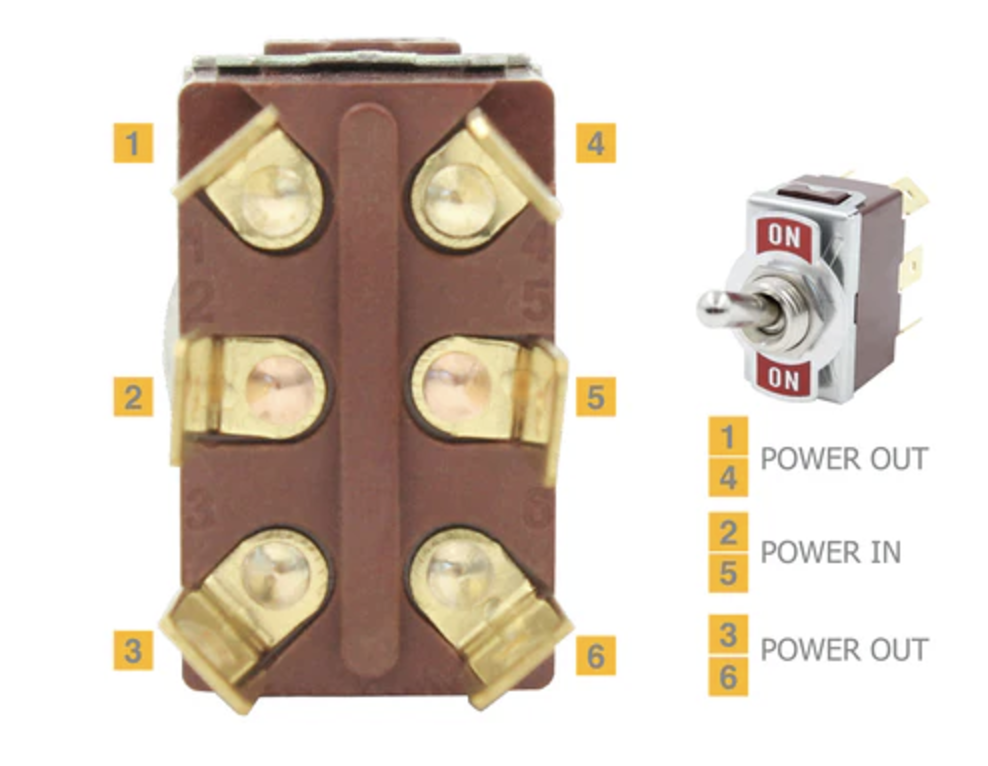
DPDT Rocker Switches
DPDT rocker switches utilize a pivoting rocker actuator. Pressing one side of the rocker closes one set of contacts, while pressing the other side closes the alternate set. They often provide a larger surface for actuation and can include illumination options. Rocker switches are prevalent in consumer appliances, power strips, automotive dashboards, and marine electronics panels, often featuring snap-in panel mounting for easy assembly.
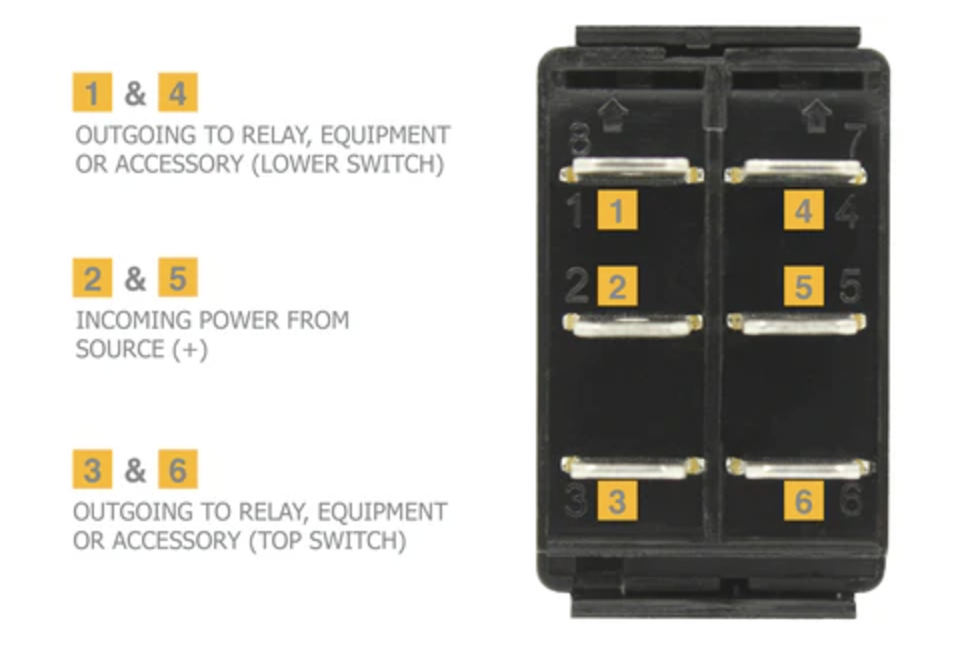
DPDT Slide Switches
These switches feature a sliding knob or button actuator that moves linearly between positions. DPDT slide switches are often more compact than toggle or rocker types, making them suitable for space-constrained applications like handheld electronic devices, mode selection on circuit boards, or toys. They are commonly available in PCB mount or panel mount styles.
(Placeholder: Image of a typical DPDT slide switch)
Momentary vs. Maintained DPDT Switches
Beyond the actuator style, the action type is crucial:
- Maintained: The switch stays in the position it was last moved to. Standard ON-ON and ON-OFF-ON switches are typically maintained.
- Momentary: The switch is only active while the actuator is being pressed or held. It usually has a spring mechanism that returns it to a default position (often the center ‘off’ in a momentary ON-OFF-ON, or one of the ‘on’ positions) when released. This is used for functions like jog controls, signal testing, or reset actions. Momentary positions are often indicated in datasheets with parentheses, e.g., (ON)-OFF-(ON).
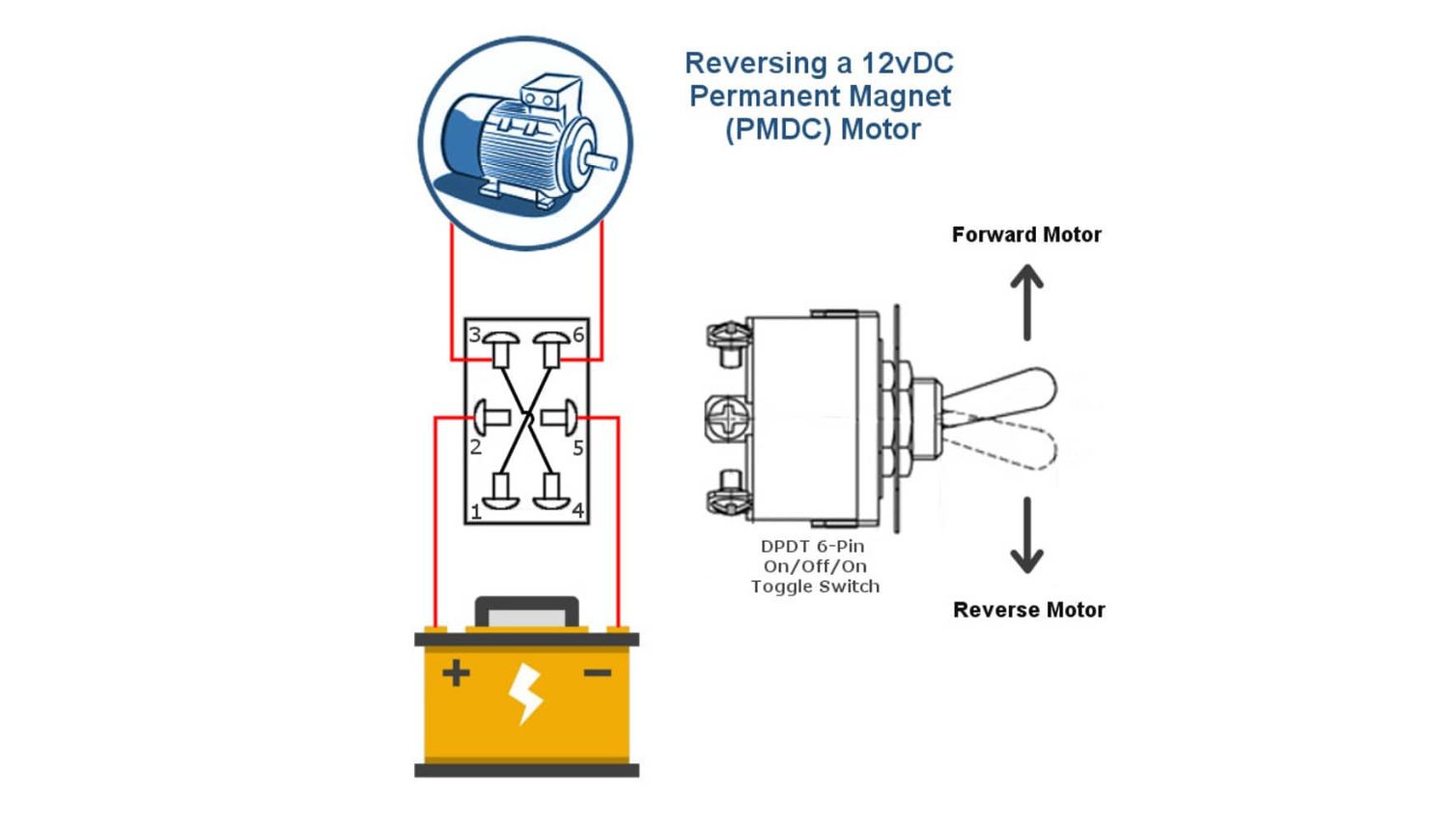
Specialized DPDT Switches (Sealed, Waterproof, etc.)
For applications exposed to moisture, dust, chemicals, or extreme temperatures, specialized DPDT switches are available. Sealed or waterproof switches (often with an IP rating like IP67) use gaskets and sealed housings to protect the internal mechanism. High-temperature variants are designed for industrial ovens or engine compartments, while others might meet specific industry standards (e.g., MIL-spec for military applications).
Real-World Applications: Where Are DPDT Switches Used?
The versatility of the DPDT switch makes it a problem-solver in numerous fields. Here are some prominent examples:
DC Motor Control and Reversing
As mentioned earlier, this is a classic DPDT application. By cross-wiring the outputs, the switch acts as an H-bridge, allowing simple forward/off/reverse or forward/reverse control of a DC motor using a single switch. This is fundamental in robotics, actuators, model vehicles, and adjustable furniture.
(Placeholder: Clear wiring diagram for DC motor reversing using a DPDT switch)
Signal Switching and Routing
DPDT switches are excellent for directing audio, video, or data signals. Examples include:
- Selecting between two different audio inputs (e.g., CD player vs. turntable) to feed a single amplifier.
- Switching a microphone output between two different preamps or recording devices.
- In test equipment, routing a test signal to one of two different measurement devices or circuits under test.
- Switching data lines in communication systems.
Model Railroads and Hobbyist Projects
Model railroad enthusiasts frequently use DPDT switches for:
- Controlling track power to specific sections (blocks).
- Reversing the polarity to a section of track to change train direction.
- Switching turnout (point) motors.
- Controlling accessories like lights or signals. Their robustness and clear action make them ideal for control panels.
Industrial Control Panels
In industrial settings, DPDT switches are used for:
- Selecting operating modes (e.g., Manual/Automatic).
- Controlling actuators or valves.
- Implementing safety interlocks where two circuits must be controlled together.
- Providing reliable control inputs in demanding environments.
Switching Between Power Sources
A DPDT switch can be used to manually switch a load between two different power sources, such as mains power and a backup generator or battery system. The double-pole nature ensures both lines (e.g., live and neutral) are switched cleanly between sources.
Complex Lighting Control
While simple lighting often uses SPST or SPDT switches, more complex scenarios might benefit from a DPDT. For instance, controlling two different lighting circuits simultaneously or implementing custom multi-way switching logic beyond standard 3-way/4-way setups.
How to Select the Right DPDT Switch for Your Application (Buyer’s Guide)
Choosing the correct Double Pole Double Throw (DPDT) switch is critical for ensuring the safety, reliability, and proper functioning of your electrical or electronic project. With numerous variations available, considering the specific requirements of your application is paramount. This buyer’s guide highlights the key factors to evaluate when making your selection.
Key Electrical Ratings (Voltage & Current)
This is arguably the most crucial specification. The switch must be rated to handle the maximum voltage (Volts, AC or DC) and current (Amperes) it will encounter in the circuit. Always select a switch with ratings comfortably above the expected operating levels. Underspecifying can lead to overheating, premature failure, arcing, or even fire hazards. Check the datasheet for both AC and DC ratings, as they can differ significantly.
Actuator Type and Style
The actuator is the part you interact with. The choice depends largely on the user interface design and operational environment:
- Toggle: Offers distinct tactile feedback, good for frequent use or when a clear visual indication of state is needed (test equipment, control panels).
- Rocker: Often aesthetically pleasing, suitable for consumer products, power switching (marine electronics, appliances).
- Slide: Compact, good for mode selection on PCBs or in tight spaces.
- Pushbutton: Can be momentary or latching, used for specific control actions. Consider ergonomics, required actuation force, and the likelihood of accidental operation.
Terminal Type for Connection
How will you connect wires or components to the switch? Common terminal types include:
- Solder Lug: Requires soldering wires directly to the terminals. Common in electronics and hobby projects.
- Screw Terminal: Allows wires (often with spade or ring connectors) to be securely clamped with screws. Common in industrial control and mains wiring.
- Quick Connect (Faston): Accepts push-on spade connectors. Widely used in appliances and automotive applications for fast assembly.
- PCB Mount Pins: Designed for direct soldering onto a printed circuit board (Through-Hole or Surface Mount). Choose the type that best suits your assembly process and skill level.

Mounting Style
How will the switch be physically installed?
- Panel Mount: Designed to be mounted through a hole in an enclosure or panel. Common types include threaded bushing (secured with a nut, typical for toggle switches) or snap-in (clips hold the switch in place, common for rocker switches).
- PCB Mount: Pins are soldered directly onto a circuit board. Ensure the mounting style matches your enclosure design and assembly method.
Environmental Considerations
Consider the operating environment. Will the switch be exposed to moisture, dust, vibration, or extreme temperatures?
- Sealing: Look for waterproof or sealed switches, often indicated by an IP (Ingress Protection) rating (e.g., IP67), if exposure to liquids or dust is likely (marine, outdoor, industrial applications).
- Temperature Range: Ensure the switch’s operating temperature range matches the application’s environment.
Certifications and Standards
For commercial products or safety-critical applications, certifications are essential. Look for markings like UL (Underwriters Laboratories), CE (Conformité Européenne), CSA (Canadian Standards Association), or RoHS (Restriction of Hazardous Substances) compliance, depending on the target market and requirements. These indicate the switch has been tested to meet specific safety and environmental standards.
Commercial Hook:
“Choosing the perfect DPDT switch involves balancing electrical specifications, mechanical requirements, and environmental factors. It can be complex. Our experts understand the nuances and are here to help you navigate the options, ensuring you find the ideal, reliable component for your specific needs. Contact us for personalized guidance and access to our wide range of high-quality switches.”
Installation and Wiring Best Practices
Proper installation and wiring are essential for safety and correct operation. Always follow guidelines and adhere to relevant electrical codes.
Safety First: Always Disconnect Power
Before starting any wiring work, always ensure the power supply to the circuit is completely disconnected. Working on live circuits can lead to electric shock, equipment damage, or fire.
Understanding Terminal Layouts
DPDT switches have six terminals, and their arrangement can vary slightly between s and models. Always consult the datasheet or ‘s documentation for the specific switch you are using. The datasheet will clearly identify the common (input) terminals and the corresponding pairs of output terminals for each throw position. Misidentifying terminals is a common source of wiring errors.
(Placeholder: Example datasheet snippet showing terminal layout)
Basic Wiring Example: A Simple ON-ON Circuit
Let’s consider wiring a simple ON-ON DPDT switch to select between two different LEDs (LED A and LED B) powered by a single source, controlling both their positive and negative connections for complete isolation.
(Placeholder: Simple, clear wiring diagram for a basic DPDT application – e.g., switching two LEDs)
- Connect the positive power source to common terminal 2.
- Connect the negative power source (ground) to common terminal 5.
- Connect output terminal 1 to the anode (+) of LED A.
- Connect output terminal 4 to the cathode (-) of LED A.
- Connect output terminal 3 to the anode (+) of LED B.
- Connect output terminal 6 to the cathode (-) of LED B. In one position, power flows through 2-1 and 5-4, lighting LED A. In the other position, power flows through 2-3 and 5-6, lighting LED B.
Common Wiring Mistakes to Avoid
- Incorrect Terminal Identification: Mixing up common and output terminals or the pairs associated with each throw.
- Short Circuits: Allowing bare wires or terminals to touch inappropriately, especially when cross-wiring for polarity reversal.
- Loose Connections: Ensure all connections (soldered, screwed, or crimped) are secure. Loose connections cause intermittent operation or overheating.
- Ignoring Ratings: Overloading the switch (see selection guide).
DPDT Switches vs. Other Common Switch Types
Understanding when to use a DPDT switch often involves comparing it to its simpler relatives.
DPDT vs. SPDT: When Two Poles Are Necessary
The key difference is the number of circuits controlled. An SPDT (Single Pole Double Throw) switch controls one input circuit, directing it to one of two outputs. A DPDT controls two independent input circuits, directing each to one of two outputs. You need a DPDT (or two SPDTs) when:
- You must control two separate circuits simultaneously with one actuator.
- You need to switch both the positive and negative lines of a DC circuit or the live and neutral lines of an AC circuit for safety or complete isolation.
- You are implementing polarity reversal (like in DC motor control).
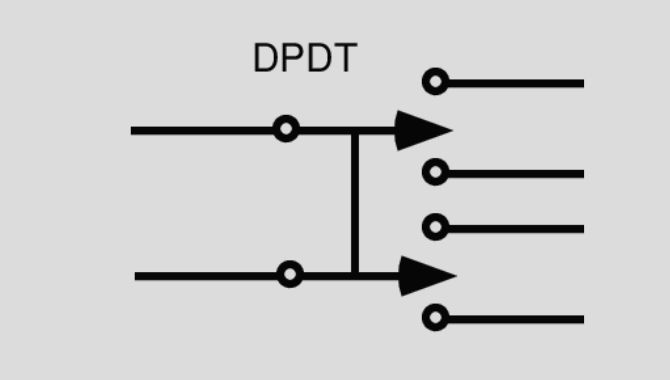
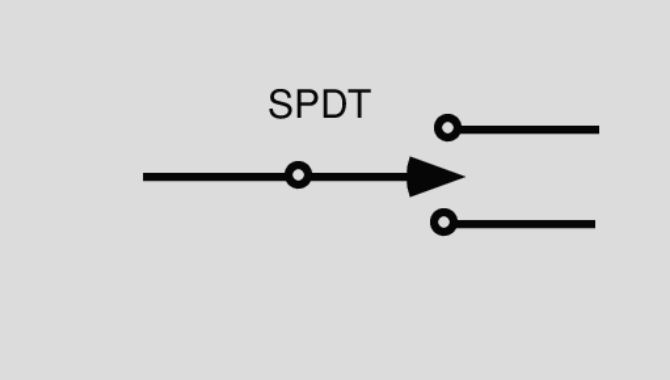
DPDT vs. DPST: The Importance of the ‘Double Throw’
Both DPDT and DPST (Double Pole Single Throw) switches control two circuits simultaneously. The difference lies in the ‘throw’. A DPST provides a simple ON/OFF function for its two circuits – each pole connects its input to its single output in the ON position and disconnects in the OFF position. A DPDT, with its double throw, allows each pole to connect its input to one of two different outputs. You need the DPDT’s double-throw capability when:
- You need to select between two different operating modes or paths for each of the two controlled circuits.
- You are implementing polarity reversal or complex signal routing.
- You require an ON-OFF-ON functionality.

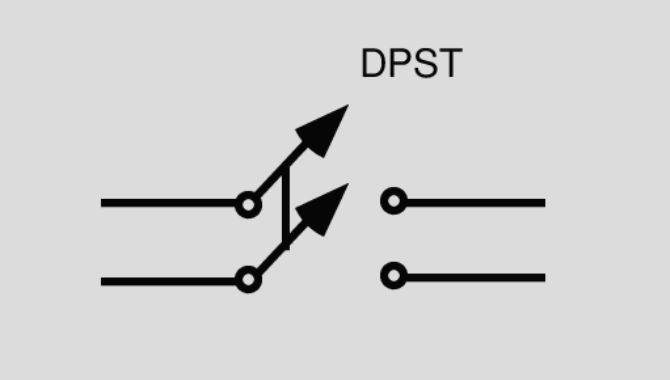
Conclusion: Your Trusted Source for High-Quality DPDT Switches
The Double Pole Double Throw (DPDT) switch is a remarkably versatile and powerful component, essential for controlling complex circuits, enabling polarity reversal, ensuring safety in mains switching, and routing signals in countless applications from industrial control to intricate hobby projects. Its ability to manage two independent circuits simultaneously with multiple output options makes it an indispensable tool for engineers and designers.
However, the effectiveness and longevity of your project depend heavily on the quality of the components used. Choosing a reliable, well-constructed DPDT switch from a trusted supplier ensures consistent performance, protects your equipment, and guarantees safety. Look for switches built with durable materials, precise mechanisms, and adherence to recognized standards.
Call to Action / Commercial Hook:
“Ready to implement the power and flexibility of DPDT switches in your next project? Explore our extensive range of high-quality toggle switches, rocker switches, slide switches, and specialized variants designed for performance and durability. We stock components suitable for diverse applications, from delicate electronics to heavy-duty industrial use.”
“Need a specific configuration, a waterproof solution, or have questions about selecting the right switch? Get in touch with our knowledgeable sales team today. We provide expert advice, competitive quotes, and are committed to helping you find the perfect DPDT switch for your requirements.”
Frequently Asked Questions (FAQ)
- Q1: What does DPDT actually stand for?
- A: DPDT stands for Double Pole Double Throw.
- Q2: Can I use a DPDT switch to control a 240V appliance?
- A: Yes, provided the specific DPDT switch you choose has voltage and current ratings suitable for 240V AC and the power consumption (load) of your appliance. Always verify the ratings in the ‘s datasheet before use. Using an underrated switch is dangerous.
- Q3: What’s the main difference between an ON-ON and an ON-OFF-ON DPDT switch?
- A: An ON-ON DPDT switch has two active positions. In each position, the common terminals are connected to one set of output terminals. An ON-OFF-ON DPDT switch adds a third, central position where the common terminals are disconnected from all output terminals, providing a true ‘off’ state.
- Q4: How many terminals does a standard DPDT switch have?
- A: A standard DPDT switch typically has six terminals: two common (input) terminals and four output terminals (two outputs associated with each common terminal).
| Voltage | Application |
| 12V | Automotive Electrical Systems UPS (Uninterruptible Power Supply) Solar Power Systems LED Lighting Portable Electronics |
| 24V | Automotive and Truck Applications Power Tools and Equipment Small Electric Vehicles Industrial Automation Equipment |
| 36V | Electric Bicycles and Scooters Power Tools Small Electric Vehicles |
| 48V | Electric Bicycles and Scooters Electric Vehicles (Light) Energy Storage Systems Power Tools |
| 110V-120V | Residential Power Systems Electronics Power Tools |
| 220V-240V | Commercial Power Supply Industrial Equipment Large Appliances |
Summary of Applications:
| Configuration | Applications |
|---|---|
| ON OFF | Ligh |
| ON ON | Circuit selecti |
| ON OFF ON | Fan spee |
| (ON) OFF ON | Vehicle |
| (ON) OFF (ON) | Motor direc |
Features
After selecting the voltage, you can choose the specific switch type for your application.
Wiring A DPDT Switch – 2 Methods Explained
Double Pole Double Throw Switch for Generator
Related Resources
Single Pole Single Throw (SPST) Switch
